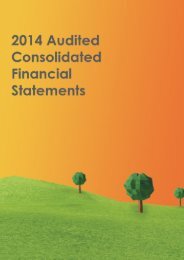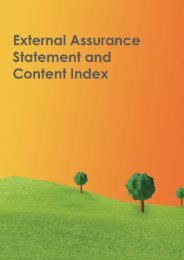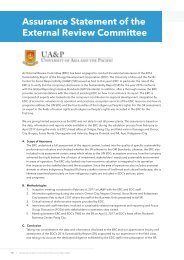EDC PR 2016 (FS section)
You also want an ePaper? Increase the reach of your titles
YUMPU automatically turns print PDFs into web optimized ePapers that Google loves.
Derivative financial instruments are initially recognized at fair value on the date on which a<br />
derivative contract is entered into and are subsequently re-measured at fair value. Derivatives are<br />
carried as assets when the fair value is positive and as liabilities when the fair value is negative.<br />
Any gains or losses arising from changes in fair value on derivatives that do not qualify for hedge<br />
accounting are taken directly to the profit or loss.<br />
For the purpose of hedge accounting, derivatives can be designated as cash flow hedges or fair<br />
value hedges, depending on the type of risk exposure.<br />
At the inception of a hedge relationship, the Company formally designates and documents the<br />
hedge relationship to which the Company wishes to apply hedge accounting and the risk<br />
management objective and strategy for undertaking the hedge. The documentation includes<br />
identification of the hedging instrument, the hedged item or transaction, the nature of the risk<br />
being hedged and how the entity will assess the hedging instrument’s effectiveness in offsetting<br />
the exposure to changes in the hedged item’s fair value or cash flows attributable to the hedged<br />
risk. Such hedges are expected to be highly effective in achieving offsetting changes in fair value<br />
or cash flows and are assessed on an ongoing basis to determine that they actually have been<br />
highly effective throughout the financial reporting periods for which they were designated.<br />
In 2012, the Parent Company designated its cross currency swaps as cash flow hedges for its<br />
exposures on foreign currency and interest rate risks on a portion of its floating rate Club Loan<br />
that is benchmarked against US LIBOR. In 2014, EBWPC designated its interest rate swaps as<br />
cash flow hedges for its exposure on interest rate risks on portions of its floating rate<br />
US$150 million ECA and US$37.5 million Commercial Debt Facilities that is benchmarked<br />
against US LIBOR (see Notes 17 and 31). In <strong>2016</strong>, the Parent Company designated its call spread<br />
swaps as cash flow hedges for its exposures on its $80.0 million term loan that is bench marked<br />
against US LIBOR.<br />
Cash Flow Hedges<br />
Cash flow hedges are hedges on the exposure to variability of cash flows that are attributable to a<br />
particular risk associated with a recognized asset, liability or a highly probable forecast transaction<br />
and could affect profit or loss. The effective portion of the gain or loss on the hedging instrument<br />
is recognized as other comprehensive income (loss) in the “Fair value adjustments on hedging<br />
transactions” account in the consolidated statement of financial position while the ineffective<br />
portion is recognized as “Mark-to-market gain (loss) on derivatives - net” under “Miscellaneous<br />
income (charges)” in profit or loss.<br />
Amounts taken to other comprehensive income (loss) are transferred to the profit or loss when the<br />
hedge transaction affects profit or loss, such as when hedged financial income or expense is<br />
recognized or when a forecast sale or purchase occurs. Where the hedged item is the cost of a<br />
non-financial asset or liability, the amounts taken to OCI are transferred to the initial carrying<br />
amount of the non-financial asset or liability.<br />
If the forecast transaction is no longer expected to occur, amounts previously recognized in OCI<br />
are transferred to the profit or loss. If the hedging instrument expires or is sold, terminated or<br />
exercised without replacement or rollover, or if its designation as hedge is revoked, amounts<br />
previously recognized in OCI remain in equity until the forecast transaction occurs. If the related<br />
transaction is not expected to occur, the amount is recognized in profit or loss.<br />
Embedded Derivatives<br />
An embedded derivative is a component of a hybrid (combined) instrument that also includes a<br />
non-derivative host contract with the effect that some of the cash flows of the combined<br />
204<br />
I Energy Development Corporation Performance Report <strong>2016</strong>
















